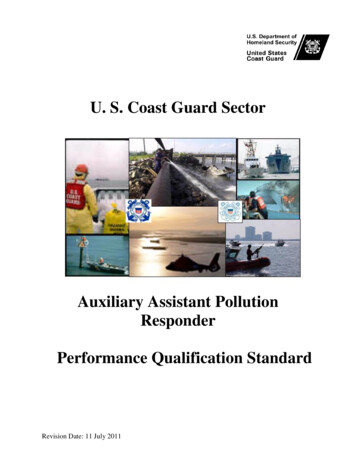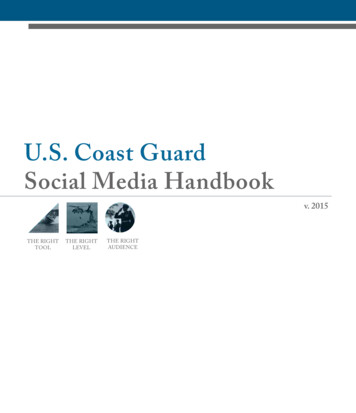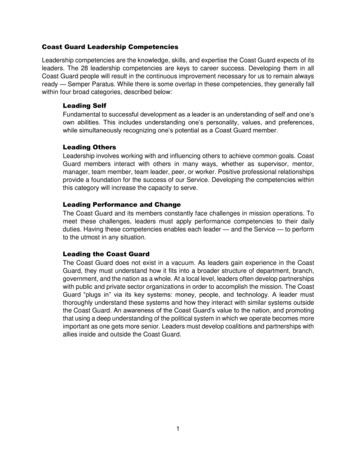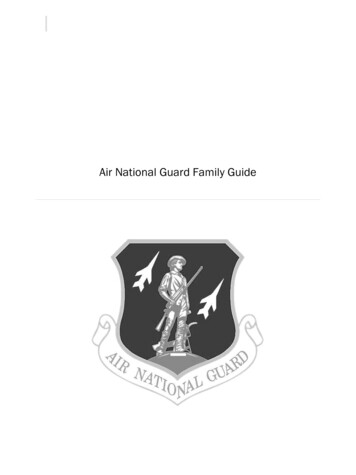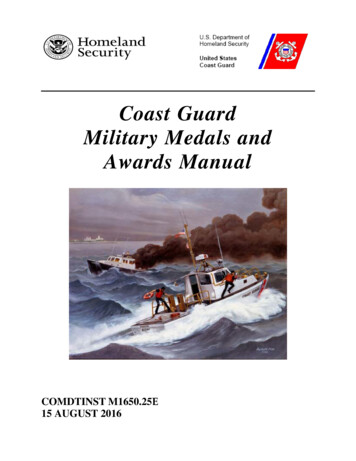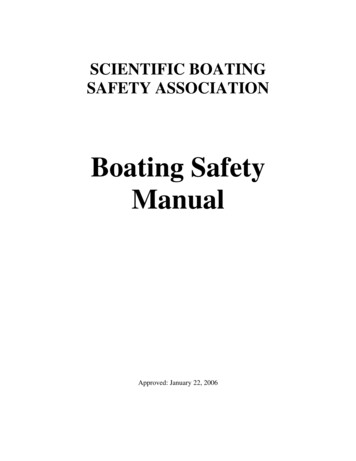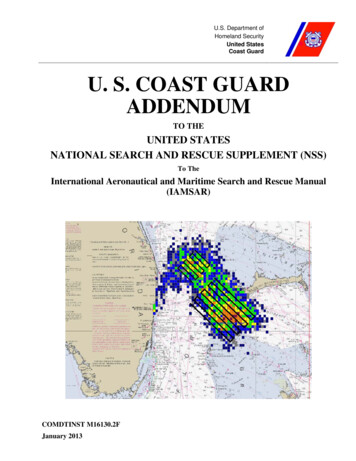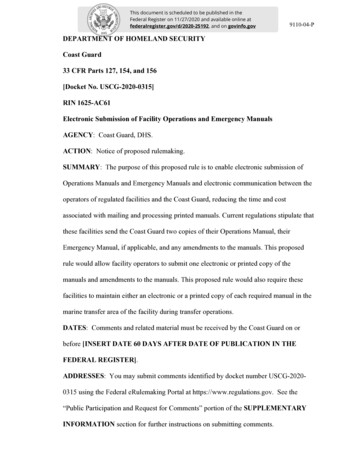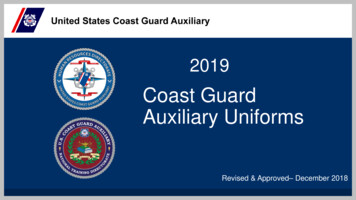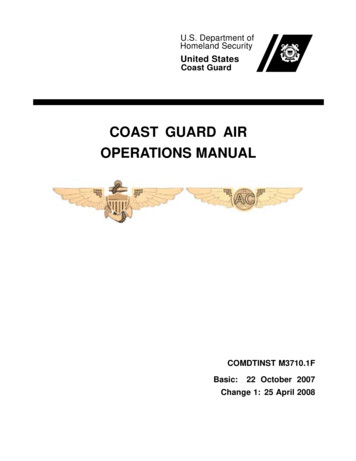
Transcription
U.S. Department ofHomeland SecurityUnited StatesCoast GuardCOAST GUARD AIROPERATIONS MANUALCOMDTINST M3710.1FBasic:22 October 2007Change 1: 25 April 2008
This Page Intentionally Left Blank
Enclosure (1) to COMDTINST M3710.1FInstructions for entering Change 1REMOVE PAGESCoverINSERT PAGESi through ii3--17 through 3--18CoverCH--1 Letter of Promulgationi through ii3--17 through 3--184--3 through 4--64--3 through 4--64--21 through 4--224--21 through 4--224--29 through 4--304--35 through 4--364--47 through 4--505--15 through 5--164--29 through 4--304--35 through 4--364--47 through 4--545--15 through 5--167--1 through 7--47--1 through 7--48--13 through 8--168--13 through 8--168--21 through 8--268--21 through 8--268--31 through 8--348--31 through 8--348--37 through 8--388--37 through 8--388--47 through 8--488--47 through 8--488--55 through 8--568--55 through 8--569--3 through 9--49--3 through 9--4D--5 through D--6D--5 through D--6I--3 through I--4I--3 through I--4Ensure entry is made on the Record of Changes page of the manual.
This Page Intentionally Left Blank
RECORD OF CHANGESCHANGEDATE OFDATEBYNUMBERCHANGEENTEREDWHOM ENTERED
This Page Intentionally Left Blank
COMDTINST M3710.1FCOAST GUARD AIR OPERATIONS MANUALCOMDTINST M3710.1FTABLE OF CONTENTSCHAPTER 1CHAPTER 2CHAPTER 3CHAPTER 4OVERVIEW OF COAST GUARD AIR OPERATIONS .1-1A. Mission of Coast Guard Aviation .1-2B. Authority and Control of FlightsC. Transportation .1-4.1-7D. Conduct of Flights .1-8E. Safety .1 - 10F.1 - 15G. Mission Planning .1 - 17FLIGHT AUTHORIZATION AND CLEARANCE .2-1A. Authority for the Coast Guard to Operate Aircraft.2-2B. Authorized Official Uses of Coast Guard Aircraft.2-3C. Authority to Approve, Direct and Initiate Flights .2-5D. Personnel Authorized to Pilot Coast Guard Aircraft .Training.2-7E. Personnel Authorized to Command Coast Guard Aircraft.2-8F.Flight Clearance Authority for Coast Guard Aircraft .2 - 11FLIGHT AND MISSION PLANNING .3-1A. Mission Planning .3-2B. Flight Planning Procedures .3-5C. Flight Planning — Aircrew .3-9D. Flight Planning — Weather .3 - 21CONDUCT OF AIRCRAFT OPERATIONS .4-1A. Conduct of Aircraft Operations.4-2B. Ground Operations.4-4C. Passengers .4-7D. Flight Rules .4-9E. Instrument Flight Requirements .4 - 12Avoidance and Reporting of Actual and Near Midair Collisions .4 - 14F.G. In-Flight Emergencies.4 - 15H. Flight Maneuvers .4 - 16I.4 - 22Flight Violations .iCH-1
COMDTINST M3710.1FContinuedTable of Contents,.4 - 23K. Night Vision Goggles (NVGs) .4 - 27L. Maintenance Flights .4 - 29M. Ferry Flights .4 - 32J.Offshore Flight Operations .N. Orientation Flights .4 - 33O. Participation of Aircraft in Flight and Static Displays.4 - 38P.Other Regulations and Considerations .Q. Weapons .CHAPTER 5.4 - 41.4 - 44R. Electronic Equipment .4 - 48S. Aircraft C4ISR Systems .4 - 52.5-1A. Overarching Principles .5-2B. Analytical Framework .5-3C. Mission Requirements Use .5-5D. Required Use.5-7E. Other Transportation for the Conduct of Official Business.5-8TRANSPORTATION.F.Transportation of Spouse, Dependents and Other Non-FederalTravelers .CHAPTER 6.5 - 13G. Special Approval and Reporting Requirements .H. Transportation of Cargo .5 - 15.5 - 17MILITARY SPACE AVAILABLE TRAVEL .6-1A. USCG Military Space Available Travel Program .6-2B. General Guidelines.6-3.C. Eligible Space Available Travelers, Priorities, and ApprovedGeographical Travel SegmentsCHAPTER 7.6-6D. Environmental and Morale Leave Program.6 - 14PERSONAL PROTECTIVE EQUIPMENT AND SURVIVALSYSTEMS . . . . . . . . . . . . . . . . . .7-1A. Protective Clothing.7-2B. Flotation Equipment .7-5C. OxygenCH-1.7-6D. Safety Devices .7-7E. Minimum Rescue/Survival Equipment .7-8ii
COMDTINST M3710.1FContinuedTable of Contents,CHAPTER 8FLIGHT CREW MEMBER DESIGNATIONS, QUALIFICATIONSAND TRAINING . . . . . . . . . . . . . . . . . .8- 1A. Administrative Requirements for Aviation Units .B. Designations.8- 2.8- 5C. Requirements for Designations.8- 7.8 - 20Pilots Assigned to Duty Involving Flying Proficiency (DIFPRO) .8 - 34Compliance with Recurrent Training Requirements .8 - 36.D. Minimum Recurrent Training Requirements for Coast GuardFlight Crew Members Assigned to Operational Flight Duty .E. Minimum Recurrent Training Requirements for Coast GuardF.G. Annual Proficiency Checks .CHAPTER 9.8 - 38.8 - 40I.Other Periodic Training .8 - 43J.Special Qualification Requirements .8 - 48K. Pilot Instrument Qualification .8 - 51L. Lapse and Redesignation .8 - 54M. Approved Simulators .8 - 58N. Coast Guard Aviator Evaluation Board .8 - 59O. Duties and Responsibilities of Standardization Units .8 - 60RECORDS AND REPORTS .9- 1A. Aviation Logistics Management Information System (ALMIS) .9- 2B. Logging of Flight Time.9- 3C. Flight Pay Entitlement Requirements.9- 4D. Classification of Flights by Coast Guard Aircraft .9- 6E. Electronic Aircraft Logbook .9- 7F.9 - 11G. Change of Pilot Designation and Qualification.9 - 13H. Miscellaneous Records and Reports.9 - 14.Aviators Flight Logbook .Glossary - 1GLOSSARYAPPENDIX A.H. Miscellaneous Proficiency Requirements .STANDARD ORGANIZATION OF COAST GUARD AIR UNITS.A- 1A. Introduction .A- 1B. General Organizational Principles.A- 2C. Standard Unit Organization .A- 3D. Duties .A- 4E. Watch Organization and Duties.A - 18.iii.
COMDTINST M3710.1FContinuedTable of Contents,.A - 19G. Recommended Management Practices.A - 20GENERAL ORGANIZATIONAL PRINCIPLES AND AIRCRAFTCHARACTERISTICS . . . . . . . . . . . . . . . .B- 1A. General Organizational Principles and Aircraft Characteristics .B- 1B. Aircraft Characteristics .B- 6C. Helicopters .B- 9D. Airplanes .B - 13EXCERPTS FROM DHS MANAGEMENT DIRECTIVE 0020.1(SERIES) . . . . . . . . . . . . . . . . . . .C- 1.C- 1B. Excerpts from DHS Management Directive 0020.1 (series) .C- 2.C - 24F.APPENDIX BAPPENDIX CUnit Orders and Instructions.A. Department of Homeland Security Aviation Management andSafety .C. Attachment 1: Cost Comparisons with CommercialTransportation .D. Attachment 2: Standard Personnel Salaries and Estimated HourlyVariable Cost Rates for Selected DHS Aircraft Flight Hours .APPENDIX DAPPENDIX EAPPENDIX F.C - 32AVIATOR FITNESS AND VISION .D- 1A. Fitness of Aircrew Personnel .B. Visual Acuity .D- 1.D- 9FAA EXEMPTION 5231H .E- 1A. FAA Exemption 5231H .E- 1B. FAA Exemption 5231H .E- 2MISHAPS AND SALVAGE .F- 1A. Mishaps and Salvage .F- 1.APPENDIX GUNDERWATER EGRESS TRAINER PERFORMANCE EVALUATIONFORM AND USCG AIRCREW SWIM TEST COMPLETION FORMG- 1APPENDIX HFLIGHT LOGBOOK GUIDE .iv.H- 1
COMDTINST M3710.1FTable of Contents,ContinuedA. Logbooks .APPENDIX IAPPENDIX JAPPENDIX K.H- 1B. Entry Instructions .H- 2C. Operational/Instrument Codes .H- 7D. Examples .H- 9COAST GUARD AUXILIARY AVIATION.I- 1A. Coast Guard Auxiliary Aviation Overview .I- 1B. Missions .I- 3FORMS .J- 1A. Forms .J- 1DISCLOSURE FOR PERSONS FLYING ABOARD FEDERALGOVERNMENT AIRCRAFT . . . . . . . . . . . . .K- 1.K- 1A. Disclosure For Persons Flying Aboard Federal GovernmentAircraft .v.
This Page Intentionally Left Blank
COMDTINST M3710.1FChapter 1OVERVIEW OF COAST GUARD AIR OPERATIONSIntroductionIn this chapterThis chapter provides an introduction to the Coast Guard Air OperationsManual, COMDTINST M3710.1 (series). A basic overview of policy andprocedures is presented.This chapter is divided into seven sections: Mission of Coast Guard Aviation Authority and Control of Flights Transportation Conduct of Flights Safety Training Mission Planning1 - 1
COMDTINST M3710.1FSection A.A.1. Missionof Coast GuardAviationMission of Coast Guard AviationOfficial Coast Guard mission programs are listed in the Abstract of OperationsReports, COMDTINST 3123.7 (series). Coast Guard Aviation is an operationsand logistics component used to support Coast Guard mission programsusing all multi-mission air assets. Operational response is the primary missionof Coast Guard aircraft. For this reason, aircraft capabilities are foundedprimarily on Search and Rescue (SAR), Enforcement of Laws and Treaties(ELT) and Marine Environmental Protection (MEP), Military Readiness andother missions requiring operational response.Various aircraft types in the Coast Guard also perform a logistical role,providing a variety of choices to tailor aviation support efficiently for differentrequirements, including cargo and personnel transportation. Coast Guardaviation is highly flexible and can be employed quickly to respond to emergentsituations. Assets can be expeditiously redistributed across the countrytemporarily to provide a “surge” capability, or to respond to special missions.Coast Guard aircraft are assigned a specific number of program hours peryear. These hours are divided among the various mission areas supported byCoast Guard aviation.A.2. PurposeThis manual prescribes general operating procedures and flight instructionsapplicable to all aircraft, including unmanned aerial vehicles and lighter thanair vehicles, operated by the Coast Guard. This manual is also intendedto provide aviation doctrine and a description of the Coast Guard aviationprogram. It can be used as a guide to mission planning and execution, as wellas for the exercise of professional judgment by those in aviation and thosewhose programs require aviation support.The chapters and appendices to this manual provide guidance to manageaviation and are directive in nature. Proven and safe procedures shall be usedin Coast Guard flight operations. The procedures and directives prescribedin this manual are derived from flight tests and operational experience ofthe Coast Guard and other Services. No provision of this manual relievespersonnel of their duty to use sound judgment or to take such emergencyaction as the situation demands.A.3. ProceduresThe procedures discussed in this manual are to be used as guides andshall be carried out with sound professional judgment. This instruction is notintended to cover every contingency that may arise, nor every rule of flightsafety and good practice.Successful operations require the exercise of good judgment and commonsense at all levels of command. When the need arises, special instructions orwaivers will be issued by Commandant (CG-711), however, in the operationalenvironment, mission demands may require on-scene deviation fromprescribed instructions or procedures when, in the judgment of the pilot incommand, such deviation is necessary for safety or the saving of life. Suchdeviation must not be taken lightly and must be tempered by maturity and acomplete understanding of the aircraft, mission, and crew.Continued on next page1 - 2
COMDTINST M3710.1FA.4. GeneralizationA.5. Updates andChanges to thisManualBecause of the need to generalize, wording such as “normally,” “etc.,”“usually” and “such as” is employed throughout this manual. Words or clausesof this nature shall not be used as loopholes, nor shall they be expanded toinclude a maneuver, situation, or circumstance which should not be performedor encountered.The most current version of this manual is posted on the Commandant(CG-711) web site at http://cgweb.comdt.uscg.mil/G-OCA/G-OCA.htm.Change requests shall be completed using the Coast Guard Air OperationsManual, M3710.1 (series) change form which is located on the Commandant(CG-711) web site under aviation publications. Only recommendations thathave been properly routed IAW the submission instructions on the form willbe accepted.1 - 3
COMDTINST M3710.1FSection B.B.1. PrimaryAuthorityB.2. ClearanceAuthority and Control of FlightsThe Commandant has primary authority for the operation of aircraft in theCoast Guard under 14 U.S.C. §§ 88 and 93A pilot in command (PIC) receives clearance for a flight from the CommandingOfficer. For scheduled flights, this is accomplished through the flight schedule.Nonscheduled flights obtain the permission of the Commanding Officer priorto departure. When this is not possible, such flights may be approved at alower level. They should be approved as soon as possible after the flight(Chapter 2, paragraph E.2).Either the Commanding Officer or the PIC may delay a mission if, in theopinion of either, conditions are not safe. The PIC has final responsibility forthe safe conduct of the mission. Specific guidance as to authority for flightsis contained in Chapter 2. In the case of flights involving transportation ofpassengers or cargo, guidance may be found in Chapter 5.B.3. Commandand ControlCommand and Control (C2) of Coast Guard aviation assets is maintained ina strategic sense by Commandant, in an operational sense by area, districtand sector commanders, and in a tactical sense by air station commandersand commanders of vessels with embarked or deployed helicopters andUnmanned Aircraft Systems (UASs). Elements of C2 are delegated to asubordinate command, such as an aviation detachment, when lines ofcommunication are distant or when it is critical to the completion of themission to have command and control in the actual theater of operations.Aviation missions are planned with the concurrence of the appropriateoperational commander having oversight responsibility.Except for Air Station Washington, the operational commanders are district orarea commanders. Two special use aircraft, currently a C–37 and a C–143,are assigned to Air Station Washington and are primarily used as long rangecommand and control platforms for Coast Guard senior leadership.Like Air Station Washington, the Coast Guard Aviation Training Center (ATC)in Mobile, AL, is a Headquarters unit. It provides HU–25 aircraft under theoperational command of the Eighth District. H–60 and H–65 helicopters, aswell as HU–25 airplanes at ATC, are used for pilot training and are underoperational control of Commandant (CG-711).All Atlantic Area C–130 aircraft are under the operational command of thearea commander. All other Coast Guard aircraft come under the operationalcommand of the district commanders.The Coast Guard Aviation Repair and Supply Center (ARSC) in Elizabeth City,NC is a non-operational Headquarters unit which falls under the AssistantCommandant for Engineering and Logistics (CG-4). ARSC’s primary missionis to provide Air Stations with depot level maintenance, engineering, supplyand information services to support Coast Guard missions.Continued on next page1 - 4
COMDTINST M3710.1FB.3.a. OperationalControlOperational Control (OPCON) is the authority to organize and employaviation forces, assign tasks, designate objectives, and give authoritativedirection necessary to accomplish the mission. OPCON includes authoritativedirection over all aspects of Coast Guard operations and training necessary toaccomplish the missions assigned to the command.OPCON is the strategic management of an aviation force throughout awide area of responsibility (AOR) to cover the spectrum of Coast Guardrequirements, from daily operational tasking to complex, large-scale emergentresponse. OPCON resides with the Area Commander and is typicallydelegated to the District Commander. OPCON for ATC Mobile resides withCommandant (CG-711).B.3.b. Tactical ControlB.3.c. AdministrativeControlB.4. ExecutionTactical Control (TACON) is the command authority for aviation forces madeavailable for tasking. TACON is limited to the detailed direction and control ofaviation resources in the operational area necessary to accomplish assignedmissions. TACON is inherent in OPCON, however the OPCON authority maydelegate TACON of a certain number of its assets to another operationalelement without releasing OPCON. TACON of aviation assets typically restswith the Commanding Officer of the air station for which those assets areassigned.Administrative Control (ADCON) is the responsibility to administrativelysupport operational personnel. ADCON includes personnel management,logistics, maintenance support, individual and unit training, discipline, andsimilar matters not included in the operational missions of the subjectorganization. There are few situations where shifting ADCON of Coast Guardaviation forces would be prudent. However, consideration may be given toshifting ADCON of a cutter deployed helicopter for deployments greaterthan six weeks.Execution of an aviation mission is accomplished at the lowest level possibleconsistent with management and coordination of all assets participating in themission. If only a single aviation asset is involved, the PIC is responsible forthe execution of the mission.For Aviation Special Missions (ASM) involving multiple aircraft (e.g., VerticalInsertion (VI), Airborne Use of Force (AUF)) an Air Mission Commander(AMC) shall normally be assigned and will be responsible for the overallmission execution. If aviation assets are operating jointly with surface or otherassets, the AMC shall be responsible for execution of the aviation portion ofthe mission.For Maritime Homeland Security (MHS) missions involving multiple aircraft(e.g., Vertical Insertion (VI), Airborne Use of Force (AUF)), an AMC shallnormally be assigned and will be responsible for the overall mission execution.If aviation assets are operating jointly for other missions (e.g., SAR) withsurface or other assets, the AMC shall be responsible for execution of theaviation portion of the mission.(continued on next page)Continued on next page1 - 5
COMDTINST M3710.1FB.4.a. Execution(continued)B.5. AircraftConfigurationControlIf two or more aircraft are operating jointly for other missions (e.g., SAR), theresponsibility for the mission normally passes to the PIC of the aircraft withthe better communications capabilities. When working with surface forces,responsibility for coordinating air and surface mission execution normallyrests with the surface element having the greatest communications capability.The Coast Guard has established an Aircraft Configuration Control Board(ACCB) to review all proposed aircraft modifications and changes. AircraftConfiguration Control is one of the most critical elements in ensuring theoverall safety of aircraft, standardization of aircraft/mission equipment, andlogistical support of aircraft and aircraft related systems. As such, no aircraftmodifications or changes will be made without specific authorization fromCommandant (CG-41) and (CG-711) and no in-flight testing will be conductedwithout specific authorization from Commandant (CG-711).Any authorization to modify aircraft and/or conduct tests must consider awide range of factors including: Structural loading Aerodynamic characteristics Weight and balance Electrical load analysis Aircraft performance Prototype installation and development test and evaluation (DT&E) Trial installation and operational test and evaluation (OT&E) Electromagnetic Interference (EMI)/Electromagnetic Compatibility (EMC)testing TEMPEST testing for COMSEC systems and equipmentThe ACCB Process Guide is maintained by Commandant (CG-41).1 - 6
COMDTINST M3710.1FSection C.C.1. GeneralTransportationThe carrying of passengers and cargo on Coast Guard aircraft is strictlyregulated. Because of the cost of operating aircraft and the public scrutiny ofpassenger transportation, it is necessary to ensure passengers who ride onCoast Guard aircraft have a genuine need to do so.The basic policy for transportation on Coast Guard aircraft is contained inOMB Circular A-126, Improving the Management and Use of GovernmentAircraft; and 41 CFR Chapters 300-304. This policy is interpreted by theAviation Management and Safety, Department of Homeland Security (DHS)Management Directive (MD) 0020.1 (series) (excerpts of which are includedin this manual as Appendix C, Management and Use of Department ofHomeland Security Aircraft), providing guidance for all aircraft operated withinthe Department off Homeland Security, including Coast Guard aircraft. DHSManagement Directive 0020.1 (series) is to be used as the primary referencesource when making specific transportation request determinations.In general, the method of transportation that entails the least cost to thegovernment will be the one employed.Transporting mission essential cargo is considered an operational and validuse of an aircraft. The carrying of cargo is subject to regulations similar tothe regulations governing the carrying of passengers. Federal and militaryregulations prescribe the method of carrying hazardous materials aboardaircraft (see Chapter 5, section H).C.2. Requests forTransportWhen requesting transportation on Coast Guard aircraft, the requestingagency or office must provide sufficient information so that transportationfeasibility may be determined. The general information required to enter thedetermination process is in Chapter 5 of this manual. It is the responsibilityof the requester of the transportation, not the Coast Guard unit providing thetransportation, to provide this information.1 - 7
COMDTINST M3710.1FSection D.Conduct of FlightsD.1. GeneralD.2. RiskManagementA variety of factors shape the manner in which flights are conducted. Theguidance concerning the conduct of flights on Coast Guard aircraft is dividedinto mission planning and mission execution. This guidance may be found inChapter 3 and Chapter 4 of this manual.Pilots manage an aircraft to minimize the inherent risk of critical mechanicalfailure occurring at the most crucial moment. For example, in a fixed wing(F/W) aircraft, the determination of an aircraft’s ability to take off safely isbased on the assumption that the single most critical engine will fail at themost critical point in the takeoff.If the aircraft is capable of either aborting the takeoff or safely executing thetakeoff at the moment of failure, the takeoff is permitted. As another example,a helicopter aircrew may, under certain conditions, have to enter a hoverknowing that if one engine fails during the hover, the helicopter will be unableto maintain flight. Under those circumstances, the pilot must minimize theduration of the maneuver and hover over the clearest and least congestedarea possible.This concept of contingency planning is embedded in military, FederalAviation Administration (FAA), and International Civil Aviation Organization(ICAO) aviation standards. Operational commanders, commanding officers,and aircraft commanders are faced with making mission decisions, and theycarefully weigh the urgency of each mission and assess the benefits to begained versus the risks involved. While all possible contingencies cannot beaddressed, the following paragraphs establish policy guidelines to be used inmaking risk versus gain analyses for various aircraft missions.D.2.a. National DefenseD.2.b. Search andRescue (SAR) and LawEnforcement (LE)D.2.b.(1) WarrantedEffortsDue to its status as an armed force under 14 U.S.C. § 1, damage to orsacrifice of the aircraft is acceptable in the defense of the United States, itscitizens, and/or installationsFor SAR missions, potential risks to the aircraft and crew shall be weighedagainst risks to the personnel and/or property in distress if the mission isnot undertaken. Probable loss of the aircrew is not an acceptable risk.Additionally, the individuals making the decision shall consider the effects ofexposing the personnel in distress to the additional risks associated with flightoperations, especially if the physical condition of those persons in distressis already impaired. In the case of LE, potential risks to the aircraft shall beweighed against the risk of bodily harm to LE personnel, hostages, andinnocent parties if the mission is not undertaken.The probability of saving human life warrants a maximum effort. This includesthe use of maximum effort takeoff and landing procedures as defined in theC-130 flight manuals. When no suitable alternatives exist and the missionhas a reasonable chance of success, the risk of damage to or abuse of theaircraft is acceptable, even though such damage or abuse may render theaircraft unrecoverable.Continued on next page1 - 8
COMDTINST M3710.1FD.2.b.(2) WarrantedRisks — Human LifeD.2.b.(3) WarrantedRisks — PropertyD.2.b.(4) WarrantedRisks — EvidenceD.2.b.(5) Logistics andOtherThe possibility of saving human life or the probability of preventing or relievingintense pain or suffering warrants the risk of damage to or abuse of the aircraftif recovering the aircraft can be reasonably expected.The probability of saving property of the United States or its citizens warrantsthe risk of damage to the aircraft if the value of the property to be saved isunquestionably greater than the cost of aircraft damage and the aircraft is fullyexpected to be recoverable.The possibility of recovering evidence and interdicting or apprehendingalleged violators of federal law does not warrant probable damage to orabuse of the aircraft.Logistics or other missions having little or no urgency shall not be prosecutedif they expose the aircraft to hazards greater than those encountered duringthe course of routine missions.1 - 9
COMDTINST M3710.1FSection E.SafetyE.1. GeneralE.1.a. BackgroundE.1.b. Human FactorsThe fundamental reasons for a comprehensive aviation safety program arethe well being of personnel and the preservation of limited resources. Toachieve this goal, the Coast Guard safety program establishes organizationalrequirements to identify hazardous situations, take corrective actions toreduce risks and/or eliminate danger, and disseminate information to promotethe safety and occupational health of military and civilian personnel. TheSafety and Environmental Health Manual, COMDTINST M5100.47 (series),provides specific guidance for the flight safety program.The concept of flight safety dates back to 1942 when the Army Air Corpssuffered more losses in training mishaps than in combat action. To reversethe trend, military leaders implemented a comprehensive aviation safetyprogram that immediately reduced training accident rates. As military pilotsmigrated to the developing commercial aviation industry, they brought theirexperience and faith in aviation safety programs with them. Whether ingovernment or commercial aviation, the precept remains the same: ensureflight operations are conducted in the safest possible manner consistent withmission requirements.During the early 1970s, a succession of mishaps involving “state-of-the-art”commercial airliners renewed interest in aviation safety programs. Whileanalyzing these accidents, National Transportation Safety Board (NTSB)investigators identified “human factors” as a significant and common element.The realization that “pilot error” was contributing to more and more mishapscaused the FAA, international safety organizations, the military, andcommercial airline companies to expend significant energy and money tolearn more about “human factors” and their relationship to critical errors byflight crews.E.1.b.(1) StudiesE.2. Monitoringand ControllingHuman factors studies focused primarily on physical factors impacting theability of flight crews to exercise good judgment. Chief among those factorswas fatigue. Stressors like constant vibration, loud noises from machineryand radios, illness or poor physical conditioning, improper diet, and irregularor insufficient sleep patterns can create both immediate and long-term (i.e.,chronic) fatigue. Studies indicated any decrease in a flight crew member’sability to function normally will greatly increase the likelihood of error. Thisinfluence becomes particularly significant during operations at night or inpoor weather conditions.The Coast Guard monitors and controls crew mission days, flight time, andother fatigue related factors. Tools like crew utilization standards are notdesigned to hinder operational commanders in mission planning or execution;rather, they are designed to minimize injury and damage and to preservelimited capital and personnel resources for future use.E.3. The AviationSafety ProgramContinued on next page1 - 10
COMDTINST M3710.1FE.3.a. Safety AttitudeE.3.b. CommandEmphasisE.3.c. Aviation SafetyGoalE.3.d. Aviators andAviation MishapsE.3.e. Aviation MishapCommunicationE.3.f. Risk ManagementEffective aviation safety is an attitude, not an add-on. For aviation safety tobe truly effective, safety must be a pervasive notion supported by leadershipthroughout Coast Guard aviation. Safety is a team effort focusing onoperations and engineering with the common goal of improved operationalperformance by reducing mishap losses.Effective aviation (flight) safety requires continuous command emphasis andleadership example. If hazards are recognized and effectively reduced oreliminated, mishap potential will be reduced and the operational effectivenessof the air unit will be enhanced. Experience has shown that a strong commandmishap prevention (loss control
Coast Guard aviation. A.2. Purpose This manual prescribes general operating procedures andflight instructions applicable to all aircraft, including unmanned aerial vehicles and lighter than air vehicles, operated by the Coast Guard. This manual is also intended to provide aviation doctrine and a description of the Coast Guard aviation program.
